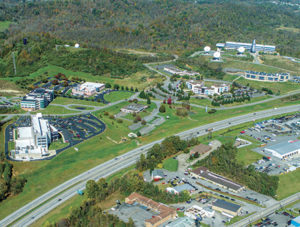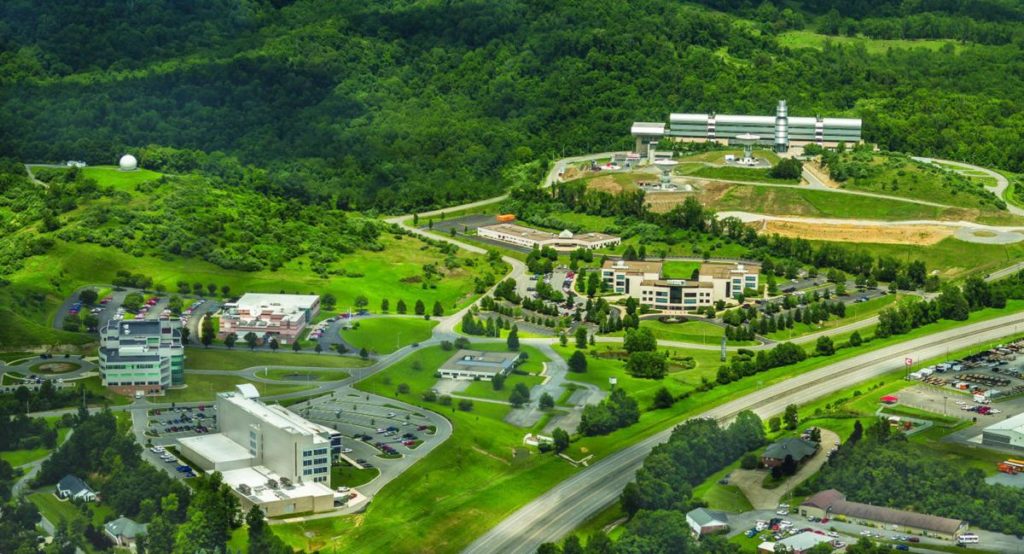November 16, 2018 Posted In: Fall 2018 Featured Articles
By Samantha Cart

West Virginia’s High Technology Foundation is focused on creating economic diversification by building up the state’s knowledge sector with the addition of companies like Leidos, a high-tech giant with operations in Fairmont, Clarksburg and Morgantown that is generating new work, new jobs and new opportunities in the Mountain State.
For years, community and state leaders, economic analysts and higher education officials have been calling for West Virginia to diversify its economy. While the Mountain State has long relied on the mineral extraction industry to employ its people and sustain its budget, it is obvious the national and global economies are moving toward the knowledge sector—a trend that weighs heavily on states that depend on a limited range of industries.
“West Virginia needs to be diversified in such a way that it will allow the state to participate meaningfully in the national economy,” says Jim Estep, president and CEO of the High Technology Foundation. “The goal should be to position West Virginia to play a bigger role in the growing knowledge sector.”
All Hands on Deck
The High Technology Foundation’s strategy for diversifying the state’s economy is known as the federal anchor model, which involves recruiting federal operations, or anchors, to the region in the hopes of establishing a competitive new business sector.
“Most companies in the knowledge sector are attracted to those areas that have a workforce with a high educational attainment,” says Estep. “This is a problem because for as long as I can remember West Virginia has been ranked 50th in educational attainment. This is not because West Virginians are stupid or don’t want to go to school. We have been so undiversified and focused on coal that the workforce requirements have driven down how much education our workforce needs. We have to take a different approach to positioning West Virginia as part of the national economy. The approach we’ve been following at the tech park is to try to build a business case or a reason for knowledge sector companies to want to come to West Virginia that is strong enough that even though we have such a bad workforce demographic from an educational attainment standpoint, they will come here anyway.”
Following the federal anchor model approach, Estep looks to Washington, D.C. for federal operations with specific characteristics. The targeted federal operations must have a science, technology, engineering and math—or STEM—orientation and generate a great deal of contracting opportunities for other knowledge sector businesses. Once these federal operations are identified, the staff at the High Technology Foundation works tirelessly to entice them to set up shop in the Mountain State.
“Once the federal operations that do all of this contracting are here, other companies notice that there is a reason to be in West Virginia—because there is all this money to be made,” says Estep. “Then you start to create an ecosystem of businesses.”
Over the last 10 years, the High Technology Foundation has had a lot of success drawing federal anchors to the I-79 Corridor, including the National Oceanic and Atmospheric Administration (NOAA) Environmental Security Computing Center, NOAA Geostationary Operational Environmental Satellite backup satellite ground station, NOAA Joint Polar Satellite System backup ground station, U.S. Department of Commerce Enterprise Security Operations Center, NOAA Continuity of Operations Site C, Leidos and various Federal Bureau of Investigation (FBI), National Aeronautics and Space Administration (NASA) and U.S. Department of Defense (DoD) programs.
Letting Down the Anchor
The ultimate goal of the federal anchor model is for the anchor companies to eventually establish a larger presence in West Virginia to bolster their regional headquarters, leading to more corporate investments.
“The value is in the level of contracting activity,” says Estep. “As that evolves, matures and grows and that critical mass gets bigger, we hope that one day it gets big enough that it truly forms the basis of an economic sector in the state that has as much economic output as coal or natural gas.”
This is exactly where Leidos fits into the model. A high-technology solutions and engineering company, Leidos has locations in 39 states, 60 locations worldwide and 31,000 employees. A relatively new company built from two legacy companies, Leidos is a merger of parts of the Science Applications International Corporation and Lockheed Martin. While Lockheed Martin has had a footprint in the Mountain State with the FBI since 1996, the company’s present-day locations are a direct result of the federal anchor approach.
Today, Leidos has offices in Clarksburg, Fairmont and Morgantown and employs 332 West Virginians. The company actively bids on work in the state and has several high-dollar contracts, including a $364 million, 10-year contract with the National Energy Technology Laboratory, or NETL, in Morgantown for support services.
The company has two offices in Morgantown, including its agile software center of excellence, which supports many of its programs across the country with software development and quick-turn solutions. The two Morgantown locations employ 140 West Virginians, many of whom were recruited straight out of a state university.
Leidos also has a contract with the DoD for its Automated Biometric Identification System, or ABIS, a biometric information technology system for identity superiority that provides critical identification services to soldiers. ABIS is parallel to the FBI’s Next Generation Identification program, which Leidos also built and actively supports.
“Any time people run fingerprints in this country for anything, whether they are arrested or whether they are applying for a job as a bank teller, they are run through the FBI system,” says Art Ibers, senior vice president and operations manager for the civil group at Leidos. “With ABIS, imagine the technology you use every day in terms of biometrics—iris, face, palm and finger—being used to identify known or suspected terrorists. That work is in Fairmont and Clarksburg.”
Leidos recently won the bid on a contract for the NOAA Enterprise Security Operations Center, which could evolve into one of the largest cybersecurity programs in the country, according to Estep.
“This program being located in West Virginia is why cybersecurity was included in the West Virginia Forward report,” he says. “It represents an important basis for an industrial cybersecurity sector in the state.”
The Perfect Port
While Leidos has a national and international footprint, the company enjoys the ease of access, capable workforce and support infrastructure West Virginia and the I-79 Technology Park provide.
Jim Preaskorn, Department of Justice/FBI strategic account executive for Leidos, is a West Virginia University (WVU) graduate who was able to return to his adopted home state thanks to his position with the high-tech company.
“The High Technology Foundation has put a lot of technology infrastructure in this park, and we are leveraging all of it,” he says. “We’re close to WVU and Fairmont State University, and that is where we grab a lot of our young talent. There are also a lot of small businesses and local foundations we work with, and we’re able to form partnerships here in the area.”
According to Ibers, West Virginia offers Leidos a competitive workforce at the forefront of technology, thanks in large part to the company’s relationships with the state’s universities.
“We have abundant access to skilled labor from those universities,” he says. “We’re doing most of our growth indigenously, hiring in West Virginia. There are a lot of software engineers and a lot of talented people in the Mountain State who love the state for a variety of reasons and don’t want to move to the Silicon Valley or the D.C. area. The federal government is moving capabilities out of the D.C. area, and that is the whole beauty of the West Virginia I-79 Corridor. For us, it’s a perfect combination of being able to be more competitive with really good talent and having our customers move there as well.”
For Estep, Leidos’ investment, growth and commitment to West Virginia is a perfect example of his vision for the federal anchor model.
“I am extremely appreciative of Leidos for stepping up and making the corporate commitments it has made,” says Estep. “In that regard, it can serve as an example for other companies. Leidos is not only chasing work that is here, but in the case of its work in Morgantown, it actually brought that work here. That is an important stage of the evolution and maturity of what we’re trying to build. The fact that it is happening with one of the big companies demonstrates that we are expanding, evolving and growing in the direction we want to go.”
At the Helm of Diversification
While Leidos is creating jobs and stimulating the state’s economy, its most significant impact is keeping Mountaineers at home—including Preaskorn.
“I worked for the FBI in D.C., and when I got the opportunity to come back to West Virginia, of course I jumped at it,” he says. “The cost of living is lower here in West Virginia, the people are nicer, and the quality of life is so much better. That is what attracts people.”
And it is the people that make West Virginia an environment where Leidos will continue to do business.
“We will continue to pursue opportunities as they come up with the FBI, NASA, NOAA, the DOE and other government agencies, especially as the government works to move more capabilities out to this corridor,” says Ibers. “We’re going to continue to execute work in Morgantown for our programs across the country and really across the world, and we will continue to use university relationships and the high-tech park.”
Article originally published by West Virginia Executive on November 16, 2018


